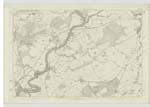OS1/25/15/23
| List of names as written | Various modes of spelling | Authorities for spelling | Situation | Description remarks |
|---|---|---|---|---|
| Site of a RELIGIOUS HOUSE dedicated to St Hunnand [Chapel Hole] | Chapel Yard Monastery (Site of) Chapel Yard Monastery (Site of) Chapel Yard Monastery (Site of) Chapel Yard Monastery (Site of) |
James Macbeth Esqr. Factor Stobhall John Scott, Burnside John Pirnie, Mason Burrelton Peter Stewart, Woodhead |
074 | A small plot of ground planted with Oak, and enclosed by a very thick stone wall portions of which are now much delapsed. John Scott, J. Pirnie, (the latter whose progenitors had lived, & been tenants here for some generations) Say that the above wall is the only evidence now left of a Monastery which had belonged to the "Abbey of Coupar Angus". At the N.W. [North West] angle is the ruins of a small house, and the ruins of another are clearly to been seen a little to the westward, these Mr. Pirnie, says, were dwelling houses. "Upon the top of a high rock which rises perpendicular above the Linn of Campsie, in a most romantic situation, stand the ruins of an old religious house, dependent on the Abbey of Cupar." New Stat. Acct. [Statistical Account] "By a deed dated 24th. Oct. [October] 1538 Donald Campbell then Abbot of the Abbey of Cupar, let in lease for 19 years to Mr. Archibald Macbroke, Advocate, & his heir male, the places and lands of Campsey, with the fishings thereon, together with the forrestrie of Campsey on payment of £20. _____ & bring sufficient Wax to St. Hunnand's lyght and Chapel &c &c This Mr. Macbroke was probably both a priest & lawyer, who conducted the business before the Kings Courts & the Church, and the place of Campsey seems to have been a retreat for the Abbot and Monks when they were disposed either for pleasure or devotion. The Abbey of Cupar was supplied with fuel from the wood of Campsey & the road they made use of to convey it thither is still called the Abbey Road." Old Stat A/C [Old Statistical Account] |
Continued entries/extra info
[Page] 23Sheet 74-9 -- Parish of Cargill -- Perthshire
[Initials beneath Name:]
J.B.
Lt.Col. [Lieutenant Colonel]
[Additional quotations:]
"We now return to the Fair Maid of Perth
who had been sent from the horrible scene
at Falkland, by order of Douglas, to be
placed under the protection of his daugh-
ter, the now widowed Duchess of Rothsay.
That lady's temporary residence was a
religious house called Campsie, the ruins
of which still occupy a striking situation
on the Tay. It arose on the summit of a
precipitous rock, which descends on
the princely river, there rendered pe-
culiarly remarkable by the cataract
called Campsie Linn, where its waters
rush tumultuously over a range of
basaltic rock, which intercepts the
current like a dike erected by human
hands. Delighted with a site so
romantic, the Monks of the Abbey
of Cupar reared a structure there,
dedicated to an obscure Saint, named
St. Hunnand, and hither they were
wont themselves to retire for pleasure
or devotion."
Fair Maid of Perth
p [page] 384
"Campsie in the Parish of Cargill where it
appears that the Abbot had a residence to which
he and his friends occasionally retired. The
tenant of Campsie bound himself to make
payment of .... sufficient wax to St. Hunnand's
lyght and Chapel.
Although traces of the ruins of a Chapel
& burial ground are still visible at Campsie,
and the track by which fuel was conveyed is
still called Abbey Road (see page 20), nothing is known
of the Site of St. Hunnand's Chapel, which apparently
stood in the neighbourhood.
A small portion of the building, an Archway stands
at the S.W. [South West] corner of the Churchyard"
Jervise's Memorials
Transcribers who have contributed to this page.
Alison James- Moderator, GMB
Location information for this page.
Linked mapsheets.




